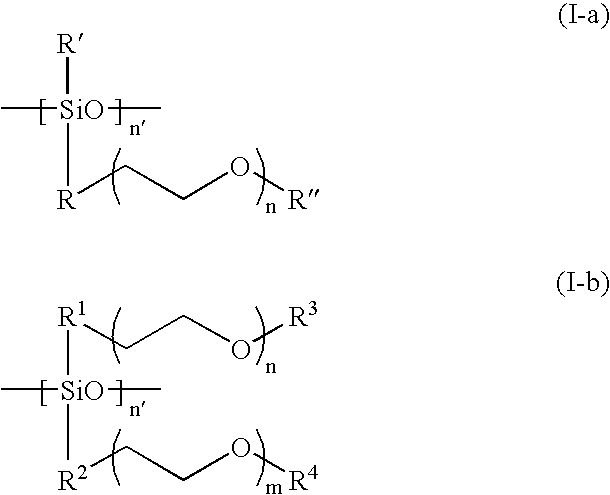Solid polymer electrolyte and method of preparation
a polymer electrolyte and solid-state technology, applied in the direction of wound/folded electrode electrodes, non-aqueous electrolyte cells, sustainable manufacturing/processing, etc., can solve the problems of low ambient temperature ionic conductivity of such highly branched peo, inability to successfully develop room temperature spe-based batteries, and inability to reduce the ionic conductivity at certain temperature, so as to reduce the ionic conductivity of the resulting ipn sp
- Summary
- Abstract
- Description
- Claims
- Application Information
AI Technical Summary
Benefits of technology
Problems solved by technology
Method used
Image
Examples
examples 1-2
[0044] For Examples 1-2, Li(CF.sub.3SO.sub.2).sub.2N (LiTFSI) salt was dissolved in a branched type siloxane polymer (n=7.2, R' and R" are methyl groups in formula I-a, M.sub.n=ca. 2000), poly(ethylene glycol) ethyl ether methacrylate (PEGEEMA) with average M.sub.n of ca. 246 and poly(ethylene glycol-600) dimethacrylate (PEGDMA600) with average M.sub.n of ca. 740 mixture. After clear dissolution of LiTFSI, benzoyl peroxide was added into the resulting solution and mixed to get a precursor solution for IPN type SPE. The composition of Examples 1-2 is shown in Table 1. Porous polycarbonate membrane is used as a supporter for the IPN SPEs. The ionic conductivity of the IPN polymer electrolytes at temperatures ranging from 25 to 80.degree. C. were measured from the ac impedance curves of 2030 button cells assembled by sandwiching the IPN SPE between two stainless steel discs with a frequency range from 1 MHz to 10 Hz. The result is shown in FIG. 1. Both of two IPN SPEs show high ionic c...
example 3
[0045] FIG. 6 is a trace of current density vs. potential during repeated voltage sweep of a cell made according to this invention at a scan rate of 5 mV / sec. It shows the electrochemical stability with 60 wt % branched type siloxane polymer (n=7.2, R' and R" are methyl groups in formula I-a infra), 30 wt % poly(ethylene glycol) ethyl ether methacrylate, 10 wt % of poly(ethylene glycol-600) dimethacrylate and Li(CF.sub.3SO.sub.2).sub.-2N. More specifically, it shows the electrochemical stability of IPN SPE with the same composition as Example 1. Polypropylene melt-blown type nonwoven separator material is used as a supporter for this IPN SPE. The electrochemical stability window of this IPN polymer electrolyte was determined by cyclic voltammetry with a 2030 button cell assembled by sandwiching this IPN SPE between a stainless steel disc as a working electrode and lithium metal disc as the counter and reference electrodes. This IPN SPE shows an excellent electrochemical stability wi...
example 7
Lithium Ion Transference Number
[0048] Li metal / IPN SPE of Example 2 / Li metal cell was assembled for the measurement of Li ion transference number t.sub.+. A 2030 button cell was used. A potentiostatic curve (FIG. 8a) was measured by using dc polarization method and the change of the cell impedance before and after polarization (FIG. 8b) was examined by using Schlumberger model 1255 frequency response analyzer connected to Schlumberger model 1286 electrochemical interface and EG&G PAR 273 potentiostat. The Li transference number was given by following equation suggested by K.M. Abraham et al., Chem. Mater., 9, 1978 (1997): 1 t + =I s R b s ( V - I oR i o) I o R b o ( V - I sR i s)
[0049] Wherein V is the dc potential applied across the symmetric cell, o and s represent the initial and steady state, and b and i represent bulk and interfacial resistance of the electrolyte.
[0050] Lithium transference number of IPN SPE of Example 2 was approximately 0.29, which is much improved over that ...
PUM
| Property | Measurement | Unit |
|---|---|---|
| conductivity | aaaaa | aaaaa |
| melting point | aaaaa | aaaaa |
| ionic conductivities | aaaaa | aaaaa |
Abstract
Description
Claims
Application Information
 Login to View More
Login to View More - R&D
- Intellectual Property
- Life Sciences
- Materials
- Tech Scout
- Unparalleled Data Quality
- Higher Quality Content
- 60% Fewer Hallucinations
Browse by: Latest US Patents, China's latest patents, Technical Efficacy Thesaurus, Application Domain, Technology Topic, Popular Technical Reports.
© 2025 PatSnap. All rights reserved.Legal|Privacy policy|Modern Slavery Act Transparency Statement|Sitemap|About US| Contact US: help@patsnap.com



